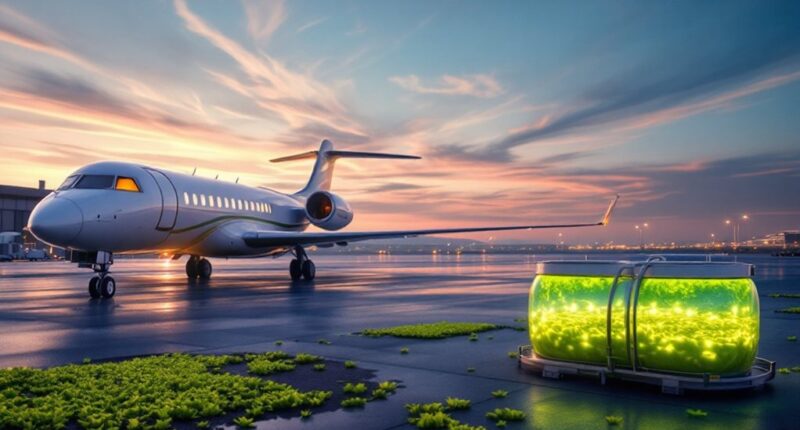Sustainable Aviation Fuel (SAF) stands at the forefront of decarbonizing air transport. This low-carbon alternative jet fuel, made from used cooking oil and agricultural residues, can blend with traditional jet fuel without a hitch. Imagine swapping out some of your favorite ingredients in a recipe—it’s that simple! With potential lifecycle CO2 emissions cut by up to 80%, SAF fuels greener flights. Exciting innovations are brewing, and there’s much more to uncover about its game-changing future!

Sustainable Aviation Fuel (SAF) is not just another buzzword in the aviation industry; it’s a game-changer that could reshape how we think about flying. Imagine a world where hopping on a plane doesn’t feel like an environmentally negligent act but rather a responsible choice. SAF, a low-carbon fuel produced from sustainable feedstocks, acts like the superhero of jet fuels. It’s chemically similar to traditional jet fuel, meaning it can be blended up to 50% with the usual suspects without requiring any aircraft modifications. Certified by ASTM International, it’s ready for commercial takeoff.
The production methods behind SAF are as diverse as a buffet line. From Hydroprocessed Esters and Fatty Acids (HEFA) to Fischer-Tropsch (FT) synthesis, and even Alcohol-to-Jet (AtJ) conversion—these methods are the culinary geniuses behind this eco-friendly concoction. Feedstocks come from an array of sources, like used cooking oil (yes, your leftover fries might have a second life) and agricultural residues, to more innovative options like algae, which are basically nature’s fast-growing green machines. Moreover, the use of biogenic feedstocks helps absorb carbon dioxide during growth, making SAF more sustainable. The Open Knowledge Repository supports innovation, providing access to research that can help accelerate the adoption of SAF technologies.
Diverse production methods and sustainable feedstocks make SAF an eco-friendly hero in the aviation industry.
The environmental benefits of SAF are tantalizing. It reduces lifecycle CO2 emissions by up to 80% and lowers emissions of sulfur oxides and nitrogen oxides. Some production methods can even achieve net-negative CO2 emissions. Picture cleaner air around airports—now that’s something to cheer for!
However, the current market status shows SAF still has some growing pains, meeting less than 0.1% of global jet fuel demand as of 2022. With only a handful of commercial producers and more than 450,000 flights utilizing SAF since 2011, the journey is just beginning.
As we look to the future, projections suggest a potential 65% reduction in aviation emissions by 2050. With ongoing research into 100% SAF-compatible engines and new production pathways, the skies may soon be a little greener. So, buckle up; the future of flying is looking bright and sustainable.
Frequently Asked Questions
What Are the Main Types of Sustainable Aviation Fuels Available Today?
Today’s sustainable aviation fuels (SAF) can be likened to a buffet of eco-friendly options. First up, Hydroprocessed Esters and Fatty Acids (HEFA) reign supreme, crafted from waste oils and boasting an impressive 80% emissions reduction.
Then there’s Alcohol-to-Jet (AtJ), turning corn and sugarcane into jet fuel. Power-to-Liquid (PtL) wields the most potential, capturing CO2, while Fischer-Tropsch (FT) transforms waste into fuel.
Each type promises a greener sky, but still needs a little development magic
How Does Sustainable Aviation Fuel Impact Aircraft Performance?
Sustainable aviation fuel (SAF) impacts aircraft performance in impressive ways. It boasts comparable, if not superior, engine efficiency compared to traditional fuels. With a lower fuel mass needed for the same distance, planes enjoy a fuel burn advantage of up to 3%.
Plus, SAF reduces harmful emissions and particulates, making engines cleaner and potentially lowering maintenance costs. It’s like swapping out a gas-guzzler for a sleek electric ride—better performance and a kinder touch on the planet
Are There Specific Regulations Governing Sustainable Aviation Fuel Usage?
Regulations around sustainable aviation fuel (SAF) are as intricate as a game of chess. For instance, the ICAO CORSIA sets emissions targets, while the EU ReFuelEU mandates increasing SAF blending.
It’s like a recipe where the ingredients must pass certain tests—ASTM standards guarantee compatibility with aircraft. With over 40 countries eyeing SAF policies, the aviation landscape is gearing up for a greener future. Who knew flying could be so eco-friendly and regulated?
What Is the Cost Comparison Between Traditional and Sustainable Aviation Fuels?
When comparing traditional jet fuel to sustainable aviation fuel (SAF), the price difference is striking. In 2022, SAF cost between $3.11 and $6.14 per gallon, often two to seven times pricier than its conventional counterpart.
This steep price tag stems from production costs, limited supply, and varying regulations. However, as technologies advance and production ramps up, experts predict SAF prices will narrow the gap with traditional fuels in the coming years.
How Can Consumers Support the Adoption of Sustainable Aviation Fuels?
Consumers can champion sustainable aviation fuels (SAF) by selecting airlines committed to SAF usage, like those with public targets or active participation in SAF programs. Supporting initiatives, such as SAF certificate purchase programs or loyalty rewards, further amplifies their impact.
Making eco-friendly travel choices, like opting for direct flights and lighter bags, contributes as well. Finally, advocating for policies that promote SAF adoption guarantees that the skies may soon be a little greener, one flight at a time.









